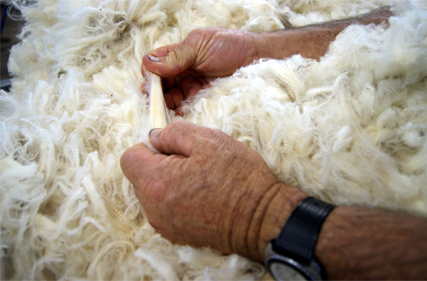
Competition was widespread as the trading exporters were visibly keen to compete on suitable lots to finalise orders before the recess.
The week signalled the last Wool Auction sale for 2021, and thankfully the challenges of 2021 did not affect the tight trading range experienced for the past 6 weeks, leaving prices largely unchanged right to the closing lot.
Currency remained relatively stable across the selling days with a slight upward movement towards the end of Wednesday’s market, which resulted in the EMI in US terms close down 6 USC.
40,862 bales were offered across Sydney, Melbourne and Fremantle with a slightly elevated pass in rate of 13.7% for the week. As the week progressed, reports filtered through of some selling agents reoffering elevated quantities of previously passed in wool in this week’s sale, which, in many cases were of poor quality and poorly specified lots.
With exporters finances stretched for extended periods after the sluggish shipping timeframes have emerged as a result of COVID 19, many of these reoffered lots were unfit for the current market and attracted token bids or no Bids in the room. Keeping in mind, wool purchased this week will be unable to be shipped until the end of January, the market performed extremely well.
Merino Fleece held last week’s levels relatively well with the exception of the sub 17μ MPG lots which lost some price traction. Small increases were measured in the 18μ to 19μ fleece lots with extreme price premiums paid for the best specified, non-mulesed lots certified to Integrity Schemes at times. 19.5-22 micron lots were just maintained compared to last week’s levels.
Competition was widespread as the trading exporters were visibly keen to compete on suitable lots to finalise orders before the recess. Early stage processors found it harder to purchase the lots in the quantities they have secured in the previous weeks.
Merino Skirtings were generally well supported and similar to the fleece, lots that were suitable for their orders were pushed aggressively whilst the lots outside these main specifications were noticeably neglected. Wednesday’s market saw increases of 10-20c dearer by the close.
Crossbreds came under some price pressure especially for lots outside the specifications from the main European Crossbred buyer. This was reflected by the 16.2% pass in rate in Sydney on the final selling day which were primarily made up of lots bearing high VM, poorly prepared and/or the containing heavy colour/cotted wool.
Merino Cardings had a solid week with little or no price change measured, with the exception of MC lots with low VMC which attracted keen competition on the final day of selling. Crossbred Oddments continued their dual market performance. Finer than 26μ were fully form whilst the coarser lots erratic and cheaper as they got coarser and heavier VMC.
I think most industry players are relatively comfortable with the wool markets performance over the past 3 months despite the nuances in shipping finance and logistics as a result of the COVID 19 pandemic.
The new normal for exporters is that the finance cycle has slowed substantially when exporting wool. These logistic problems have created huge costs increases in the movement of shipping containers. In some cases, getting shipping containers into China, India & Europe have risen 5 to 7 times their pre-Covid cost levels. Exporters cannot see this changing anytime soon and I assume many exporters will be increasing their credit limits.
On a more positive note, the EMI began the 2021 calendar year at 1,172 cents, then added 186c over the course of the year (+15.9%). The total dollar amount of wool sold in Australian Auctions in 2021 is up $332m with a total sold of $1.132 billion dollars. A combination of increased volume and the value of our merino clip contributing heavily to this improving metric.
Our largest challenges relate to the control of the COVID pandemic around the world. We can only hope and pray the increase of vaccination rates assist in the resolve in the domestic and international border restrictions to allow movement of shearing teams to return to their annual migration patterns. The return to some normality of the international logistics and restoration of the traditional Bricks and Mortar retail outlets.
All in all the wool industry has managed the Covid 19 situation relatively well, avoiding sale interruptions, and keeping the face to face sales in the auction rooms in all centres was the result of a dedicated team of Industry service providers working with State Government Health Departments to stay ahead of the challenges.
We are extremely thankful to all those who contributed to these positive outcomes including our selling team who spent months in home isolation to allow sales to continue.
The market now heads into the annual three-week Christmas recess. Sales will resume in the week commencing the 10th of January.
The crystal ball remains relatively cloudy into 2022 and beyond, however I believe the demand for Merino Wool will continue to be positive.
Crossbreds are more of a challenge and opportunities for increased prices are extremely limited, especially the coarser end, which has a bulging stockpile worldwide.
-Marty Moses, Moses and Son
